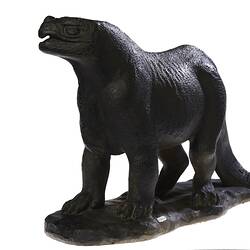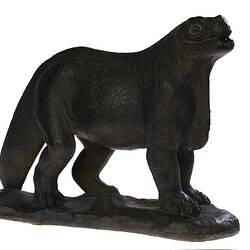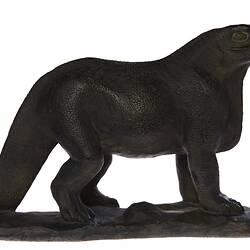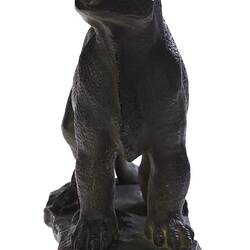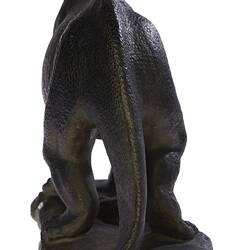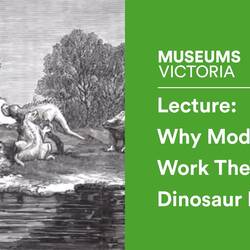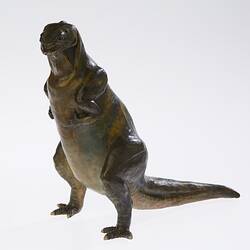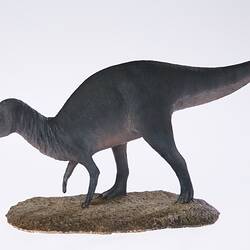Summary
This model is a one-twelfth scale version of the first sculpture of Iguanodon ever produced. The original was revealed in 1854 in Crystal Palace Park in London, where it still stands today, along with other life-sized models of extinct animals. Fossils of Iguanodon had been collected in England from the 1820s. They were mostly isolated bones and teeth, or partial skeletons scattered during burial. Palaeontologists Gideon Mantell and Richard Owen correctly determined that these fossils belonged to a giant, extinct reptile.
Owen, founding Director of the Natural History Museum, London, worked with the models' sculptor, Benjamin Waterhouse Hawkins, to produce a scientifically up-to-date version of Iguanodon. Waterhouse Hawkins also commissioned the series of miniature replicas to which this model belongs. Dinosaurs were popular in the 1850s as they are today, and there was a ready private market for the models. As well, miniatures could be easily sent to schools, universities, and museums worldwide. Public education and social progress were high priorities during the Victorian era, when these models were made. This miniature demonstrates its maker's intent to share revolutionary knowledge about the natural world with an audience beyond the visitors to Crystal Palace Park. These models would also have argued to audiences that the United Kingdom was at the forefront of scientific discovery, and asserted cultural dominance over distant colonial populations, such as in Australia.
Since that time, research using more complete fossils of Iguanodon, as well as larger shifts in our thinking about dinosaurs, has shown that this model embodies many mistakes and misunderstandings. Its teeth are ridged and leaf-shaped, and are similar to the living iguana - the name Iguanodon means "iguana tooth". For this reason, Owen suggested a short spiked bone found in partial fossils was a horn on the animal's nose, like a green iguana today. Around 25 years after the models were produced, near-complete fossil skeletons of Iguanodon were found in Bernissart, Belgium. The bones of these skeletons had remained in life position, and showed that this "horn" was in fact a spike on the tip of Iguanodon's thumb. While Iguanodon most likely spent time on all fours, it was also able to walk on its hind legs only. Tendons running along its backbone held its tail out straight, rather than dragging on the ground, and it was not nearly as bulky and elephant-like as in this version.
At the time, most scientists considered dinosaurs to be sluggish and even flabby reptiles. In part this was based on comparison with living reptiles, but it was also a convenient idea to explain why dinosaurs could have gone extinct - perhaps outcompeted by "superior", energetic mammals. Our understanding of Iguanodon today is very different. Bone growth studies show it had a higher metabolism, and would have grown to maturity more quickly than living reptiles. Trackways and mass-death fossil deposits show Iguanodon and its relatives moving together in herds, and could pace a typical person running at 25 km/h. Models like this help us understand the history of research on Iguanodon, and also illustrate how scientific discoveries have changed people's view of dinosaurs over the past 160 years.
Specimen Details
-
Taxon Name
-
Author and date of publication
Meyer, 1832
-
Date Identified
1872
-
Number Of Specimens
1
-
Sex
Unknown
-
Category
-
Scientific Group
-
Discipline
-
Collecting Areas
-
Type of Item
Taxonomy
-
Kingdom
-
Phylum
-
Subphylum
-
Class
-
Order
-
Family
-
Genus
-
Species Name
mantelli

